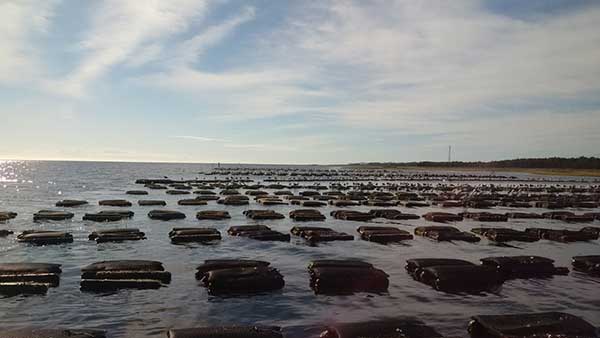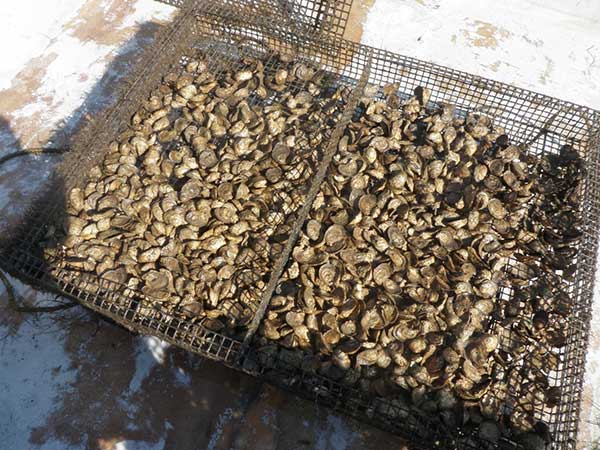By Brooke Bauman

For some North Carolinians, oysters have run in the family for decades. And really, it’s a good business to get into. Those fancy oysters you slurp up at restaurants can go for 50 cents per piece, according Joel Fodrie, a coastal researcher with UNC’s Institute of Marine Sciences. That can add up quickly. Fodrie said even a plot as small as five-acres can yield over $100,000.
According to the North Carolina Division of Marine Fisheries, oyster production increased from 11,330 to 32,515 bushels between 2011 and 2017. The industry’s growth is cause for celebration among oyster advocates, but 2017 harvests are still less than five percent of North Carolina’s legendary 1902 harvest of 800,000 bushels.
The state is chasing the glory days of oysters because they see the potential for North Carolina to achieve “Napa Valley” status for oyster production. That status could come with economic opportunities and environmental benefits of cleaner waterways.
In 2016, the North Carolina General Assembly recognized the industry’s potential and started planning for how to grow it.
They called on the North Carolina Policy Collaboratory to gather the major players in the shellfish aquaculture industry into a working group dubbed the Shellfish Mariculture Advisory Committee, or SMAC. Their goal would be to produce a report advising the legislature on how to best support the industry while accounting for the concerns of multiple interest groups.
In 2018, SMAC’s recommendations were released in the report called “North Carolina Strategic Plan for Shellfish Mariculture: A Vision to 2030.” The legislature received these recommendations and some policymakers like Representative Pat McElraft from Carteret and Jones Counties even worked directly with growers to craft Senate Bill 648, which was passed in 2019.
What’s so special about oysters?
North Carolina’s oyster craze is for good reason. North Carolina Coastal Federation scientist Erin Fleckenstein said the benefits of oysters can be summarized in three F’s. Oysters serve as a fish habitat, they produce food for us and other organisms, and they have water filtering capacities by removing excess chemicals. For example, oysters can actually remove excess nitrogen from water because nitrogen is a component of their shells. So when oysters are harvested, the nitrogen leaves the water.
But beyond the three F’s, there’s also a sense of community among fishers that Fleckenstein and her colleagues hope to expand. “It’s culturally important to North Carolina to have a strong and vibrant commercial fishing community,” Fleckenstein said.
Fleckenstein oversees the Oyster Steering Committee to strategize about the future of oysters in North Carolina. The committee is a non-regulatory body comprised of stakeholders such as researchers, restoration specialists, coastal managers, permit officers, oyster fishermen, and educators. The committee grew out of a need to connect all people working on the issue.
Every five years, the committee revises their state oyster blueprint which maps out oyster development in the state. Often the plan will incorporate economic development strategy, building new oyster habitats called sanctuaries, and promoting oyster farming. Once the committee finalizes the plan, their work is just getting started.

“Another big component of the Steering Committee is not only having these collective goals and actions but also collectively communicating it to our policymakers and legislators,” Fleckenstein said.
Since members of the committee are often state employees, they cannot advocate for certain agendas, but they can educate legislators. Stakeholders can provide legislators with briefings on important topics or meetings, meet in person with legislators, or attend bi-annual summits.
Trends in growing oysters
Oyster farming techniques have changed over time to meet changes in demand. “It used to be that people would just put shell down on the bottom of the sound and the natural oyster larvae would come and attract to that area and then settle and grow up and then in a few years you would harvest the live oysters off of it,” Fleckenstein said.
This traditional method is known as extensive growing because you don’t have to put a lot of effort into managing and caring for the oysters. Most of this growing is historically on the bottom of the sound, ranging from the floor to 18 inches above. But now, there’s a new, more intensive method of growing oysters that’s gaining popularity.
“What’s happened over the last decade is that people got interested in moving up into the water column,” said Fodrie, the coastal researcher at UNC’s Institute of Marine Sciences. “That’s either meant having these bottom racks that extend up the 18 inch threshold or actually put oysters in bags that float at the top.”
These bagged oysters are special because they’re grown individually, producing unique shapes and sizes. They’re the ones that are sold to restaurants for 50 cents per piece so oyster farmers can make more money on the same area.

For the traditional bottom leases, other people can fish around them because the gear is located on the bottom. Water columns leases with bagged oysters may be more visible than bottom leases, which raises concerns from property developers who may be worried about decreasing property value if homeowners can see the leases from their homes. Other fishermen and people who enjoy recreational water sports may also complain that they interfere with their activities.
But these concerns haven’t stopped oyster farmers from changing their leases from bottom to water column. “There’s a little bit of a gold rush mentality where everyone’s looking at the people who are being successful and saying, ‘well gosh, I want to do that too,’” Fodrie said.
These bagged oysters have the same environmental benefit of cleaning the water, but Fleckenstein said they don’t always get the same habitat value because it’s not a permanent structure. So from an economic and environmental standpoint, Fleckenstein is not concerned by the trend toward bagged oysters. However, Fleckenstein knows that water column leases are especially vulnerable to hurricanes, which have become more intense due to the effects of climate change.
If a storm tears through the sound, the bagged oysters may separate from each other and gear may pollute the sound or become trash on the bottom. To avoid this, Fleckenstein said they are working to develop best management practices to plan for storms with oyster farmers.
The story behind the legislation
In 2016, the North Carolina General Assembly saw an opportunity to grow oyster and generally shellfish farming operations. They asked the North Carolina Policy Collaboratory to develop their plan to improve the industry. The first step in this process was to identify the concerns of stakeholders, so the Collaboratory worked with the North Carolina Coastal Federation to put together an offshoot group of the Oyster Steering Committee called SMAC.
SMAC was an open group so everyone with a connection to oyster farms in North Carolina was welcome. For about one and a half years, SMAC met once per month to hash out their plan. They had five or six working groups covering government, siting of oyster farms, science/research, regulatory matters, and developing a vision for the industry.
SMAC came to a consensus on 19 recommendations related to their subcommittees and a group of professors, including Fodrie, wrote the report and sent it to the legislature. At that point, SMAC dissolved, but the Oyster Steering Committee continues to support the growing industry.

North Carolina Senator Bill Cook introduced Senate Bill 648 to support the growth of oyster farming. Once it was passed in the Senate, the bill went to the House. Representative McElraft of Carteret and Jones counties reviewed the Senate’s bill and focused on listening to stakeholders before revising it.
McElraft responded to concerns from oyster farmers who were worried that big corporations would take over small operations. Their bill reduced the area that could be leased by one entity from 200 to 100 acres.
The House also responded to concerns that farmers should be required to produce something on a plot — many believed that you shouldn’t be able to just sit on the lease without farming. So the House set a productive minimum to define the minimum yield that the area must produce over a certain time period. They ended up making more tweaks to the bill as it went through the House.
“We also had to listen to them and say, ‘what if a storm is coming? Or what if there’s a cold snap and they can’t produce as much as they normally do?’ McElraft said. “So we had to cut that productive minimum way down, to almost half of what we had at the beginning.”
With these changes made, Senate Bill 648 passed. The model of SMAC is an example of how stakeholders can actively shape the legislative process. This legislation signals interest for growing the shellfish industry in the state, but there is more work ahead before the state can fully revive the industry’s glory days.
Stakeholders have identified a need for new programs to protect growers from storm damage. For example, McElraft said the North Carolina Coastal Federation is developing a low-interest loan program to protect growers from extreme weather and diseased crops.
They’re supposed to report back by March 15, 2020, but in the meantime, this legislation gives reason to celebrate.
Brooke Bauman is an Environmental Sciences major and Geography and Journalism minor at UNC-Chapel Hill. She is working as a Communications Intern with the North Carolina Policy Collaboratory this semester.
